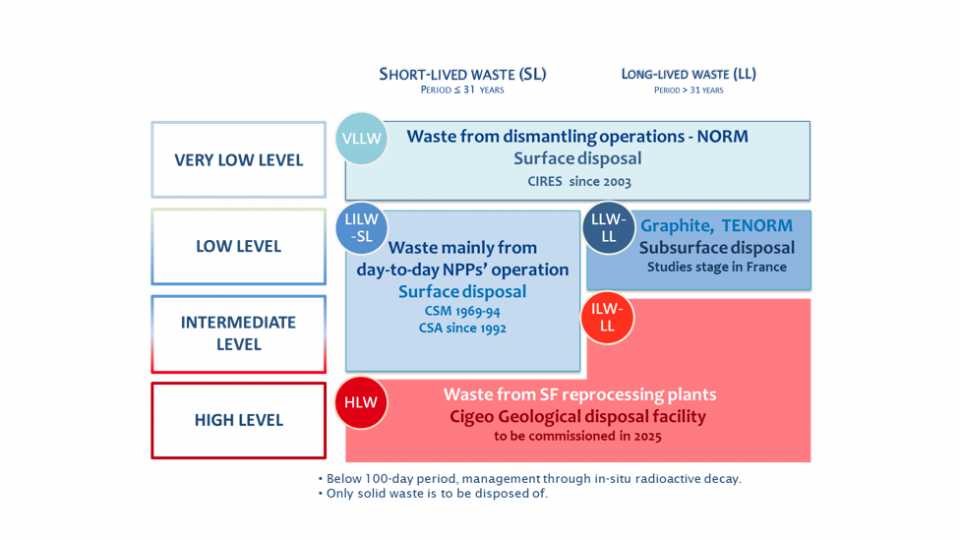Waste classification
The various types of radioactive waste produced in France vary considerably by their activity levels, their half-lives (or periods), their volumes and their contents (fission products, scrap metal, rubble, sludge, resins, etc.). The treatment and final disposal solution must be adapted to the type of waste involved, in order to manage it safely.
Radioactive waste is diverse.
Their characteristics differ from one waste to another: physical and chemical nature, level and type of radioactivity, half-life of the main radioactive elements contained.
In France, the classification of radioactive waste is based on two parameters :
The level of radioactivity
It is usually expressed in Becquerels (Bq) per gram or kilogram. Also called activity, the level of radioactivity relates to the amount of radiation emitted by the radioactive elements (radionuclides) contained in the waste. There are 4 different activity levels: high activity (HA), average activity (MA), low activity (FA) and very low activity (TFA).
Did you know it ?
In France, 98% of total radioactive waste activity in waste is concentrated in High Level waste
The half-life
It is expressed in years, days, minutes or seconds. The half-life quantifies the time at which the initial activity of a radionuclide is halved.
We distinguish between waste which main radionuclides have a short period (less than or equal to 31 years) and those of long period (greater than 31 years). For the former, it is generally considered that the radioactivity is greatly attenuated after 10 periods, ie about 300 years.
Note also the particular case of radionuclides used for diagnostic purposes in medicine, of "very short" life, that is to say their half-life is less than 100 days. After a short time, their radioactivity reaches very low levels, so they can be managed in the facilities where they are used, by decay.

Why is a waste classification needed?
The usual classification of waste, taking into account the level of activity of radionuclides and their period, makes it possible to direct radioactive waste towards the management system adapted to their characteristics.
However, it does not take into account certain degrees of complexity which lead to the retention of a management system different from that corresponding to the category to which the waste is assimilated.
Other criteria, such as stability or the presence of toxic chemicals, must also be taken into account.
In addition, the definition of a management method must take into account the general principles of the Environment Code, and in particular the need to reduce the volume and harmfulness of ultimate radioactive waste.
Two important aspects concerning the classification of radioactive waste should be emphasized:
- There is no single classification criterion for determining the class of a waste. It is indeed necessary to study the radioactivity of the various radionuclides present in the waste to position it in the classification. However, in the absence of a single criterion, the waste of each category is generally in a range of mass radioactivity indicated in the previous table;
- a waste may fall within a defined category but may not be accepted in the corresponding management chain due to other characteristics (eg its chemical composition).
Moreover, thanks to the improvement of the knowledge of the waste, during their recovery or the dismantling of the installations, as well as the progress of the studies carried out on the optimization of the modes of treatment and conditioning, the options of waste management can evolve.
The classification of radioactive waste abroad
The classification parameters of radioactive waste differ from country to country. For example, some countries, such as Japan, have chosen a classification by production chain, whereas in Germany, for example, where disposal facilities are all underground, the classification mainly concerns the exothermic nature of the waste (heat release or not).

